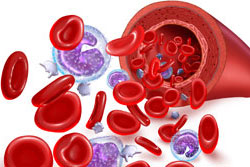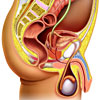Introduction to biological therapy
Biotherapies used in anti-cancer treatment include:
- Immune system-targeted therapies– exert their effects indirectly (and sometimes also directly) by boosting the immune system to work against cancer. These therapies include:
- Non-specific immune stimulators– which boost the immune system in general, rather than to fight against a particular type of cancer cell;
- Monoclonal antibodies– antibodies which have been genetically engineered to target cancer cells;
- Cytokines– synthetic copies of proteins produced by the human body which help regulate the immune system’s response;
- Vaccines- which may be used for cancer prevention or treatment;
- Endocrinological (hormonal) therapies– used in the treatment of cancer which depend on hormones for their growth (hormone-dependent cancers). These include prostate and breastcancers. These therapies, which modify hormone levels, include:
- Exogenous hormones– hormones added to the body; and
- Hormone receptor inhibitors– agents which modify the way hormones work in the human body by inhibiting the binding of hormones to cells;
- Tyrosine kinase inhibitor therapy– inhibits tyrosine kinases, enzymes which regulate cellular function like replication and proliferation;
- Gene therapy– treatment which targets genetic factors such as mutated genes;
- DNA repair enzyme inhibitor therapy– targets mutant genes which are incapable of repairing DNA properly and thus may result in proliferation of cells with damaged DNA in some types of cancer;
- Adoptive cellular therapy– uses cells harvested from the human body, which are cloned and reproduced, then put back into the body.
Immune system-targeted therapies
Non-specific immune stimulators
Non-specific immune stimulators are therapies which induce non-specific immune or inflammatory responses; that is, they stimulate the immune system as a whole, rather than stimulating antibodies for a particular disease. Non-specific immune stimulators used in cancer therapy include:
- Bacillus Calmette Guerin (BCG), for superficial bladder cancer;
- Levamisole for advanced colorectal cancer;
- Cytokines, including interferons and interleukins.
BCG is a weakened strain of the bacteria Mycobacterium bovis. It is most commonly used as a vaccination to prevent tuberculosis; however, it has been applied to anti-cancer therapy for over 3 decades. The mechanisms by which BCG exerts its anti-cancer effects are not well understood although it is thought to act by stimulating a non-specific inflammatory response by the immune system.
Levamisole for advanced colorectal cancer
Levamisole is an antihelminthic medicine which is usually used to treat infection with parasitic worms. Interest in levamisole as an anti-cancer therapy was sparked by reports that it induced a non-specific inflammatory response in animals. Early trials reported promising results for its use in the treatment of melanoma, breast and lung cancers, however, levamisole was only developed as a treatment for colorectal cancer. It is not effective enough to treat colorectal cancer when used alone. In combination with other anti-cancer medicines it is more effective, but still not as effective as other available treatments for colorectal cancer and it is not currently used to treat cancer.
Monoclonal antibodies
 Monoclonal antibodies are genetically engineered antibodies which target tumour cell antigens; that is, substances produced by cancer cells which the body recognises as foreign. They were developed to provide treatment options that were specifically targeted at cancer cells rather than affecting all cells, which is a major limitation of other cancer treatments like chemotherapy. Because of their non-specific nature, chemotherapy and other treatments are highly toxic and produce many dangerous and unpleasant side effects. Thus monoclonal antibodies were developed to reduce the toxicity of cancer treatment.
Monoclonal antibodies are genetically engineered antibodies which target tumour cell antigens; that is, substances produced by cancer cells which the body recognises as foreign. They were developed to provide treatment options that were specifically targeted at cancer cells rather than affecting all cells, which is a major limitation of other cancer treatments like chemotherapy. Because of their non-specific nature, chemotherapy and other treatments are highly toxic and produce many dangerous and unpleasant side effects. Thus monoclonal antibodies were developed to reduce the toxicity of cancer treatment.A monoclonal antibody called bevacizumab (sold as Avastin) targets a protein called vascular endothelial growth factor, which helps supply blood to growing cancer tumours. It is approved for use in the treatment of metastatic breast cancer which does not respond to chemotherapy and hormonal therapy. It has demonstrated effectiveness in reducing tumour growth and prolonging survival when used alone or in combination with other anti-cancer medicines. Another called trastuzumab (Herceptin) targets oestrogen receptors and is used in the treatment of oestrogen positive (dependent) breast cancer.
Cytokines
Cytokines are chemicals made by the body’s cells which mediate immune system responses, usually by interfering with cell receptors. They are believed to exert their anti-cancer effects by acting on immune system cells. They have been proposed as potential adjuvant therapy (treatment given after another treatment) with cancer vaccines.
Interferons
Interferons have indirect, immune stimulating actions which impair cancer growth, but also target cancer cells directly to inhibit their growth and replication. Interferon α, originally isolated from human leukocytes (white blood cells) and subsequently cloned, is the best studied interferon. It was the first biotherapy to receive approval in anti-cancer therapy in the United States in 1986. It has been shown to mediate the immune system’s response in a number of ways, including by inducing antibodies which are important predictors of survival in individuals being treated for melanoma. Interferon α has been used to treat a range of cancers including:
- Hairy-cell leukaemia;
- Chronic myelogenous leukaemia;
- Metastatic melanoma;
- Renal (kidney) cell cancer;
- B-cell lymphoma (cancer affecting the immune system’s lymph nodes);
- Cutaneous t-cell lymphoma;
- Superficial bladder cancer;
- Gastrointestinal cancers.
While more recently developed medicines are now often used instead of interferon α it may still be used in the treatment of cancer which does not improve with other treatment.
Interleukins
Interleukin-2 for renal cell cancer and melanoma
High-dose interleukin-2 monotherapy (use of only interleukin and no other medicines) is approved and routinely used to treat renal (kidney) cell cancer. It is also approved as monotherapy for melanoma. For melanoma it is the only treatment which has been demonstrated to prolong survival and disease-free progression in the long term. However, the treatment is highly toxic and can only be used to treat individuals who are young and otherwise healthy. Serious side effects, including death, mean that people using this therapy need to be admitted to hospital while they are treated.
Vaccines
Vaccines stimulate the immune system to recognise and protect against foreign substances(called antigens), and in the cancer treatment setting may be used either to prevent the development of cancer or improve the efficacy of cancer treatment. The immune system protects the body against microbes from the external environment which cause disease (some of which are associated with the development of cancer), and also against certain types of abnormal cells, including cancer cells. Immune system lymphocytes, specifically B cells and cytotoxic/killer T-cells, play distinct roles in protecting against cancer.
B cell vaccines for prevention of cancer causing disease
B cells are predominately involved in the production of antibodies which inhibit viral and bacterial particles from causing infection. Vaccines which stimulate B cells have a role in cancer prevention. When B cells produce antibodies directed against cancer-causing organisms they indirectly reduce an individual’s risk of developing the form of cancer associated with that particular infection. For instance, vaccines for preventing infection by human papilloma virus (HPV) types 16 and 18 may indirectly prevent cervical as well as anal and other cancer types, while vaccination against hepatitis B virus may indirectly prevent liver cancer.
Human papilloma vaccine for prevention of cervical and other cancers
Infection with human papilloma virus types 16 and 18 is the underlying cause of some 70% of cervical cancer and the virus also underlies the vast majority of anal cancers and a significant proportion of vaginal, vulval, penile, urethral and head and neck cancers. HPV vaccines (e.g. Gardasil) are highly effective in preventing human papilloma virus infection and subsequent cervical cancer, with limited side effects. However, cervical cancer screening by pap-smear is still recommended for women who have received an HPV vaccination.
B cell and cytotoxic killer T cell-stimulating vaccines for cancer treatment
Cytotoxic or killer T cells are a type of cell which destroy cells that have become damaged, including cancerous cells. B cells are the cells which produce antibodies for specific foreign substances in the bodies called antigens. Antigens include viruses, bacteria and cancerous substances. Vaccines which stimulate B and T cells to recognise cancer cells are being developed for use in cancer treatment.
Cancer cells, although abnormal, may not always be recognised as such by the immune system. When they are not recognised as abnormal, killer T and B cells do not mount a response against them. Most cancer cells contain self-antigens; that is, antigens which signal the immune system to recognise the cells as normal. Although cancer cells also contain cancer antigens which the immune system recognises as foreign, the self-antigens may inhibit an effective immune response against the abnormal cells. In addition cancer cells undergo other changes to prevent their recognition by the immune system.
Sipuleucel-T for treatment of metastatic prostate cancer
To date the only vaccine approved for cancer treatment is called sipuleucel-T (Provenge). It is an autologous vaccine which stimulates an immune response to prostatic acid phosphatase, an antigen commonly produced by prostate cancer cells. The vaccine is believed to exert its anti-cancer effect by stimulating T cells to kill cells producing prostatic acid phosphatase. The vaccine has been shown to increase survival in men with metastatic prostate cancer. However, as autologous vaccines are made from cells of the person who will be treated with the vaccine, an allogeneic vaccine must be developed for each person treated, using cells harvested and cultured from the person’s blood.
Endocrinological (hormone) therapy
 Endocrinological (hormone) therapy works by interfering with the production or action of particular hormones. These therapies may be used in the treatment of hormone-dependent cancers, that is; cancers which depend on hormones for proliferation. Such cancers are predominately those affecting the genito-urinary system and include prostate and breast cancers, the most common types of cancer in men and women respectively.
Endocrinological (hormone) therapy works by interfering with the production or action of particular hormones. These therapies may be used in the treatment of hormone-dependent cancers, that is; cancers which depend on hormones for proliferation. Such cancers are predominately those affecting the genito-urinary system and include prostate and breast cancers, the most common types of cancer in men and women respectively.
Testosterone withdrawal for prostate cancer
Suppression of testosterone production in the body is commonly used as a follow up (adjuvant) therapy for prostate cancer. Prostate cancer depends on testosterone and other androgens to grow, and androgen withdrawal therapy can slow or stop the growth of prostate cancer cells. Reduction of androgen production can be achieved using diethylstilbestrol (an oestrogen) or medicines which interfere with the action of luteinising hormone (the hormone which stimulates testosterone production by the Leydig cells of the testes). A combination of the two has been found to be more effective, for example one study reported a reduction in tumour size in 77% of men treated with a combination, compared to 65% treated with medicine that interfere with luteinising hormone alone.
There are, however, a number of side effects associated with androgen withdrawal therapy including reduced strength, muscle mass and bone mineral density, increased fat mass and insulin resistance. These side effects are similar to the symptoms of male hypogonadism, a condition characterised by abnormally low levels of testosterone.
Hormone therapy for metastatic breast cancer
Hormone therapy for metastatic breast cancer may involve either a single medicine or a combination of different types of hormonal medicines. All the hormonal medicines used for metastatic breast cancer work by interfering with the action of oestrogens. Usually a single medicine is used. A combination of medicines is only used when a doctor needs to suppress the function of the ovaries to reduce the amount of oestrogen they produce. Combined therapy is therefore only used to treat women who have not reached menopause.
Hormone therapy is not recommended in combination with chemotherapy.
Tyrosine kinase inhibitors
Adverse skin events including folliculitis (inflammation of the hair follicles), are the most common side effects associated with tyrosine kinase inhibitors, and occur in more than half of people treated. However, all anti-cancer medicines produce unwanted side effects and overall tyrosine kinase inhibitors are considered very well tolerated.
Gene therapy
DNA repair enzyme inhibitors
Adoptive cellular therapies
Autologous stem cell transplant
Autologous stem cell transplantation is a potentially curative treatment for metastatic breast cancer. When administered immediately after chemotherapy, the transplant replaces stem cells destroyed during chemotherapy. However, the possible benefits of use of this therapy have to be weighed against its high cost and the high risk of severe, therapy-related toxicities including death. To date there is no clear evidence of a benefit in the general population of MBC patients, however, this treatment may be recommended to individual women.
Natural killer cells and lymphokine activated killer cells
Natural killer T cells are a type of lymphocyte with inherent cytotoxic properties (i.e. they do not require activation or immunisation to induce their cytotoxic effect), which are also of interest in the development of cancer vaccines (discussed above). Unstimulated natural killer T cells have demonstrated the ability to recognise and attack tumour cells in vitro (in the laboratory). However, when used in cancer treatment the killer T cells are stimulated to increase their activity before they are administered for treatment. To date, natural killer T cell therapies have not been as effective as other treatments and they are not currently used in routine cancer care. However, they may have a role in future cancer treatment.
Lymphocytes
Tumour-infiltrating lymphocytes (white blood cells) and cytotoxic T cells have a more specific anti-tumour activity compared to natural killer T cells. They are thought to be 10 to 100-fold more potent. However, they may also suppress the immune system and have not yet been developed sufficiently for use in cancer treatment.
Biotherapies to reduce side effects
Haemopoitetic growth factors
Haemopoietic growth factors, substances which stimulate the growth of various body cells and elements, may be used as therapy to overcome bone marrow toxicity side effects of cytotoxic chemotherapy. Bone marrow is amongst the most sensitive body tissues and high-dose chemotherapy would normally stop the development of new bone marrow. Toxic effects on the bone marrow often means that chemotherapy has to be stopped, interrupted or the dose reduced, limiting the effectiveness of chemotherapy in curing cancer. During chemotherapy, haemopoitetic growth factors may be an alternative to bone marrow transplant for preventing interruptions to the chemotherapy regimen due to bone marrow toxicity, allowing more rapid increases in dose to be made.
Bisphosphonates (neoadjuvant)
Bisphosphonates are medicines which strengthen the bones. They are used in cancer treatment for individuals with bone metastasis (cancerous spread to the bone) and usually given as soon as bone metastasis is diagnosed. The majority of individuals with bone metastasis benefit from this treatment.
More information
 |
For information on breast cancer, types of breast cancer and its investigations and treatments, as well as some useful videos, see Breast Cancer. |
 |
For information on prostate cancer, including diagnoses, types of treatments, and some useful tools, videos and animations, see Prostate Cancer . |
References
- Dillman O. Cancer Immunotherapy. Cancer Biotherapy and Radiopharmaceuticals. 2011; 26(1): 1-64. [Abstract]
- Alvarez RH, Present and future evolution of advance breast cancer therapy. Breast Cancer Res. 2010; 12(Supp2): S1. [Abstract | Full Text]
- National Cancer Institute. Biological therapies. 2004. [cited 7 November 2011]. Available from: [URL Link]
- Hansen ED, Hurley BF. Intervening on the side effects of hormone dependent cancers: the role of strength training. J Ageing Res. 2011. Online version. [Full Text]
- Cardoso F, Fallowfield L, Costa A, et al. Locally recurrent or metastatic breast cancer: ESMO clinical practice guidelines for diagnosis, treatment and follow up. Annals Oncol. 2011; 22(S6): vi25-30. [Abstract | Full Text]
- Cross D, Burmester JK. Gene Therapy for Cancer Treatment: past, present and future. Clin Med Res. 2006; 4(3): 218-227. [Full Text]
- Oldham RK, Dillman RO. Monoclonal antibodies in cancer therapy: 25 years of progress. J Clin Oncol. 2008; 26(1): 1774-77. [Full Text]
- Chirgwin J, Shua SL. Management of breast cancer with nanoparticle albumin bound (Nab-paclitaxel combination regimens: a clinical review. The Breast. 2011; 20(5): 394-406. [Abstract]
- National Cancer Institute. Cancer vaccines Fact Sheet. 2011. [cited 16 November 2011] Available from: [URL Link]
- Lobert, S, Fahy J, Hill, BT, et al. Vinca Alkaloid-Induced Tubulin Spiral Formation Correlates with Cytotoxicity in the Leukemic L1210 Cell Line. Biochem. 2000; 39; 12053-62. [Full Text]
- Saslow D, Castle PE Cox JT et al. American Cancer Society Guideline for the Human Papillomavirus (HPV) Vaccine use to prevent cervical cancer. CA: A Journal for Cancer Clinicians. 2007; 57: 7-28. [Full Text]
- Mayo Clinic. Hormone therapy for prostate cancer. 2011. [cited 17/11/2011]. [URL Link]
- Guyton AC, Hall JE. Textbook of Medical Physiology (11th edition). Philadelphia: W.B. Saunders; 2006. [Book]
- Brawer MK. Hormonal therapy for prostate cancer. Rev Urol. 2006; 8(s2): s35-47. [Full Text]
- Allan CA, McLachlan RI. Testosterone deficiency in men: Diagnosis and management. Aust Fam Physician. 2003; 32(6): 422-7. [Abstract]
- Droste S, Hermann-Frank A, Schiebler F, et al. Ethical issues in autologous stem cell transplant (ASCT) in advanced breast cancer: A systematic literature review. BMC Medical Ethics. 2011; 12(6). [Full Text]
- Khwaja A, Goldstone AH. haemopoitetic growth factors. BMJ. 1991. 302: 1164-5. [Full Text]
- Hartmann JT, Haap M, Kopp HG, Lipp HP. Tyrosine kinase inhibitors- a review of pharmacology, metabolism and side effects. Curr Drug Metab. 2009; 10(5): 470-81. [Abstract]
- Arora A, ScholarEM. Role of tyrosine kinase inhibitors in cancer therapy. Perspectives Pharmacol. 2005; 315(3): 971-9. [Abstract]
- National Health and Medical Research Council. Screening to prevent cervical cancer: guidelines for the management of asymptomatic women with screen-detected abnormalities. 2005. [cited 16 November 2011]. Available from: [URL Link]
- Product Information: Sutent. West Ryde, NSW: Pfizer Australia Pty Ltd; 11 January 2012.
All content and media on the HealthEngine Blog is created and published online for informational purposes only. It is not intended to be a substitute for professional medical advice and should not be relied on as health or personal advice. Always seek the guidance of your doctor or other qualified health professional with any questions you may have regarding your health or a medical condition. Never disregard the advice of a medical professional, or delay in seeking it because of something you have read on this Website. If you think you may have a medical emergency, call your doctor, go to the nearest hospital emergency department, or call the emergency services immediately.








